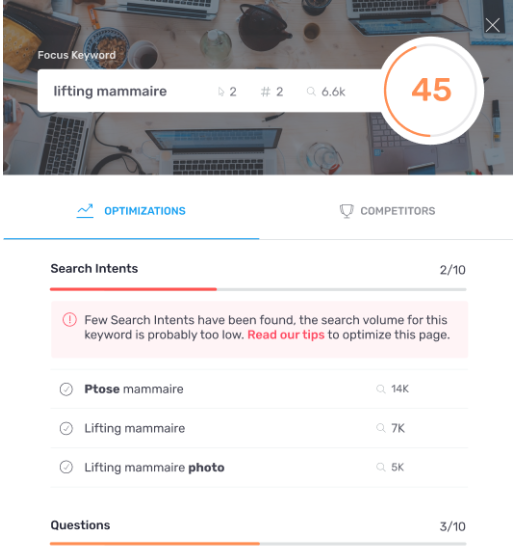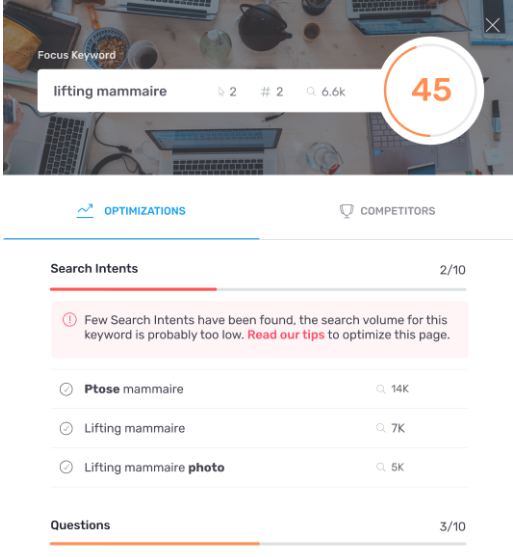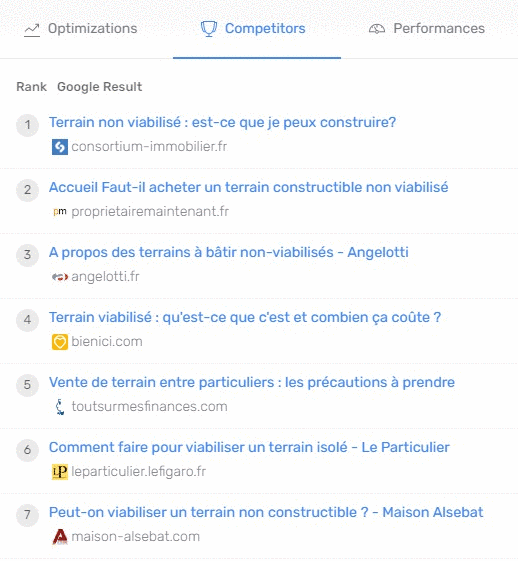To understand a borderline and exceptional case on Semji
A small number of Search Intents or Related Terms : an exceptional case
Semji offers a minimum of 20 Search Intents and 40 Related Terms recommendations on average for each Focus Keyword analysis. However, it can happen that when launching an analysis on a Focus Keyword, you get a low number of Search Intents or Related Terms recommendations.
In this case, an alert message appears, informing you of this limit case.
Instead of offering to unlock 10 Search Intents as usual, Semji offers you to unlock only the number of Search Intents that Semji has found. You will then spend exactly the corresponding number of Search Intents credits.
Example: If Semji finds 8 Search Intents after analyzing your Focus Keyword, it will offer you 8 Search Intents and you will only use 8 Search Intents credits.


Also, if Semji finds unusually few Related Terms following the analysis of your Focus Keyword, an alert message will inform you.

Explanatory hypotheses
#1 - Your keyword focus is transactional
The first assumption is that behind your Focus Keyword lies a search intent that does not call for rich editorial content in Google results pages.
For the record, launching an analysis on a Focus Keyword instructs Semji to analyze the SERP (Search engine results page) and the best competing content (those that rank first). In a few seconds, Semji analyzes their length, their structure, their semantics... it then deduplicates and clusters the intentions and Related Terms found. If the competing content is too poor, Semji has not enough material to provide recommendations.
This is both the strength - and in this case the limitation - of Semji: by analyzing those that Google judges to be the best, you give yourself the means to understand what makes them successful, and to overtake them!
This can happen when your Focus Keyword has a strong transactional intent. If the majority of the results suggested by Google are, for example, product pages from e-commerce sites, or category pages with a small descriptive text, Semji's analysis possibilities are limited. In this case, users are not looking to read paragraphs of information, but to make a purchase. Google understands this and adapts the content it positions in the first results.
Solutions:
If your Focus Keyword is too transactional, you can change it. Re-launch a new analysis on different keywords, in order to find the one that will have the most recommendations.
Nevertheless, take into account the user's intention. If you are looking to optimize a product page or a category page whose objective is to generate conversions or even transactions, it is relevant to aim for a transactional focus keyword. In this case, optimize your content with Semji's recommendations, even if they are shorter than usual. They will still allow you to do better than your competitors!
Finally, consider building a semantic cocoon to boost the performance of your transactional pages. Create several contents targeting informational Focus Keywords, and set up an internal link towards your pages with high business stakes. Results guaranteed!
#2 - SERP results block Semji crawlers
Some websites may have been designed to block some robots and crawlers. If the number one competitor on your Focus Keyword have implemented such blocks, it is possible that Semjibot is unable to read the content.
This assumption can be checked by clicking on the Competitors tab and unfolding the competitor content plans. If you see a content map and a tagged title hierarchy, then Semji reads the content without difficulty. If you don't see a map, then Semji is probably having trouble accessing the editorial content.

Most of the time, there are enough readable results by Semji to build consistent recommendations. But if the readable competitor content is poor, then you may find yourself in the borderline case we discuss in this article.
Solutions:
You can change the Focus Keyword, to get a different SERP and new recommendations. For this, you will have to launch a new analysis.
You can also choose to combine several Focus Keyword on the same content, by performing several rounds of optimization. Even if some of them have few recommendations, combining them allows you to obtain a significant number of recommendations and to produce a rich content.
Finally, you can analyze the blocked content yourself by displaying the competing urls and manually doing what Semji's AI usually does for you: reading the content, picking up the main Related Terms from the titles, paragraphs... and using them as inspiration to write your plan and your content.
#3 - The Internet user expects a specific content format
Once again, it is a matter of user intention. Search intent is not only about semantics, it can also be about format!
If your chosen Focus Keyword calls for video, image or PDF results for example then Google's SERP is likely to adapt and offer very few rich editorial results. Semji does not have enough material to analyze and its recommendations are limited.
For example, if you type "Celine Dion karaoke", all the results on the SERP are Youtube videos. It is not realistic to aim for a top 3 position using an editorial content format!
Solutions:
Your goal may be misdirected. Change your Focus Keyword to fit an editorial content. For example "Celine Dion song lyrics". Do not hesitate to analyze several Focus Keywords to compare the SERP and find the most suitable for your editorial production. While waiting for Semji to provide you with content briefs adapted to video formats, one day... :)
